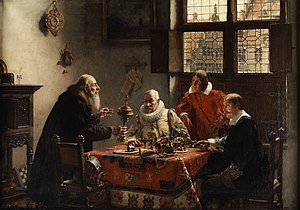Art dealer

Anart dealeris a person or company that buys and sellsworks of art,or acts as the intermediary between the buyers and sellers of art.

An art dealer incontemporary arttypically seeks out variousartiststo represent, and builds relationships withcollectorsandmuseumswhose interests are likely to match the work of the represented artists. Some dealers are able to anticipatemarket trends,while some prominent dealers may be able to influence the taste of the market. Many dealers specialize in a particular style, period, or region. They often travel internationally, frequentingexhibitions,auctions,and artists'studioslooking for good buys, little-known treasures, and exciting new works. When dealers buy works of art, they resell them either in their galleries or directly to collectors. Those who deal in contemporary art in particular usually exhibit artists' works in their own galleries. They will often take part in preparing the works of art to be revealed or processed.[1][2][3]
Art dealers' professional associations serve to set high standards for accreditation or membership and to support art exhibitions and shows.[4]
History
[edit]The art dealer as a distinct profession perhaps emerged in theItalian Renaissance,in particular to feed the new appetite among collectors for classicalantiquities,including coins. The somewhat disreputable character ofJacopo Stradais often said to be reflected in hisportrait by Titian (1567).[citation needed]
Job requirements
[edit]
Art dealers often study thehistory of artbefore entering on their careers. Related careers that often cross-over includecuratorsof museums andart auctionfirms are industry-related careers.[4]Gallery owners who do not succeed may seek to work for more successful galleries. Others pursue careers asart critics,academics, curators of museums or auction houses, or practicing artists.[5]
Dealers have to understand the business side of the art world. They keep up with trends in the market and are knowledgeable about the style of art people want to buy. They figure out how much they should pay for a piece and then estimate the resale price. They are also often passionate and knowledgeable about art. Those who deal with contemporary art promote new artists, creating a market for the artists' works and securing financial success for themselves. The art world is subject to economic booms and busts just like any other market. Art dealers must be economically conscious in order to maintain their livelihoods. The mark ups of art work must be carefully monitored. If prices and profits are too large, then investments may be devalued should an overstock or economic downturn occur.[6]
To determine an artwork's value, dealers inspect the objects or paintings closely, and compare the fine details with similar pieces. Some dealers with many years of experience learn to identify unsigned works by examining stylistic features such as brush strokes, color, form. They recognize the styles of different periods and individual artists. Often art dealers are able to distinguish authentic works fromforgeries(although even dealers are sometimes fooled).[4]
Notable art dealers
[edit]Contemporary gallery
[edit]The termcontemporary art galleryrefers to a private for-profit commercial gallery. These galleries are found clustered together in large urban centers. Smaller cities are home to at least one gallery, but they may also be found in towns or villages, and remote areas where artists congregate,e.g.theTaos art colonyandSt Ives, Cornwall.
Contemporary art galleries are often open to the general public without charge; however, some are semi-private. They profit by taking a portion of art sales; twenty-five to fifty per cent is typical. There are also many non-profit or collective galleries. Some galleries in cities like Tokyo charge the artists a flat rate per day, though this is considered distasteful in some international art markets. Galleries often hang solo shows.Curatorsoften create group shows with a message about a certain theme, trend in art, or group of associated artists. Galleries sometimes choose to represent exclusive artists, giving them opportunities for regular shows.
A gallery's definition can also include theartist cooperativeorartist-run space,which often (in North America and Western Europe) operates as a space with a more democratic mission and selection process. Such galleries have a board of directors and a volunteer or paid support staff who select andcurateshows by committee, or some kind of similar process to choose art often lacking commercial ends.
Vanity galleries
[edit]Avanity galleryis an art gallery charging fees from artists to show their work, much like avanity pressdoes for authors. The shows lack legitimate curation and often include as many artists as possible. Most art professionals are able to identify them on an artist's resume.[7][8]
Professional organizations
[edit]
- Antique Tribal Art Dealers Association,Inc. (ATADA)
- Art Dealers Association of America (ADAA)
- Art and Antique Dealers League of America (AADLA)
- Association of Art and Antiques Dealers (LAPADA)
- British Art Market Federation (BAMF)
- British Antique Dealers' Association(BADA)
- Confédération Internationale des Négociants en Oeuvres d'Art (CINOA)
- Fine Art Dealers Association (FADA)
- French art dealers committee
- New Art Dealers Alliance(NADA)
- Private Art Dealers Association (PADA)
- Society of London Art Dealers(SLAD)
- The European Fine Art Foundation (TEFAF)
See also
[edit]- List of art dealers
- Appraiser
- Art finance
- Art market
- Art sale
- Art valuation
- Auction
- Blockage discount
- Curator
References
[edit]- ^The Art Gallery - Volume 14, Issue 2.Hollycroft Press. 1971. p. 86.
...we require no such guarantee of the artist's 'presence'. We are prepared for the work of art to be revealed or processed. In the plastic arts the artist ' s signature, factually and figuratively, assumes prime importance. "Factually, if not figuratively, most editions of multiples bear the artist's...
- ^Hulst, T. (2017).A History of the Western Art Market: A Sourcebook of Writings on Artists, Dealers, and Markets.University of California Press. p. 106.ISBN9780520290624.Retrieved15 June2020.
... which information is processed by the structure of collectors, dealers, agents and auction...
- ^Alan D. Bryce,Art Smart: The Intelligent Guide to Investing in the Canadian Art Market,Dundurn, 2007.ISBN1550026763,9781550026764
- ^abc"Collector's Guide to Working with Art Dealers, 45th Anniversary Edition"(PDF).New York: The Art Dealers Association of America (ADAA). Archived fromthe original(PDF)on October 8, 2013.
- ^Career: Art Dealer, The Princeton Review
- ^Cowley, Stacy (2008-04-16)."Amid art boom, dealers brace for a bust".Fortune Small Business.Retrieved2008-06-03.
- ^"Investing in Your Career, A Worthwhile Risk?".New York Foundation for the Arts (NYFA). Archived fromthe originalon 22 July 2012.Retrieved16 June2012.
- ^"Art Gallery".Wednesday, 9 June 2021
External links
[edit] Media related toArt dealersat Wikimedia Commons
Media related toArt dealersat Wikimedia Commons- Cartoon Strip about Art Dealers in The TatlerRetrieved February 2013
